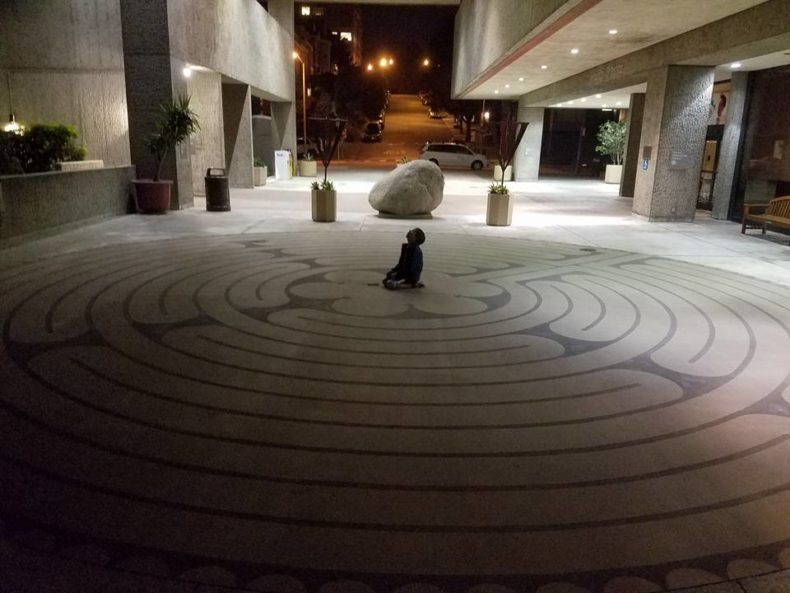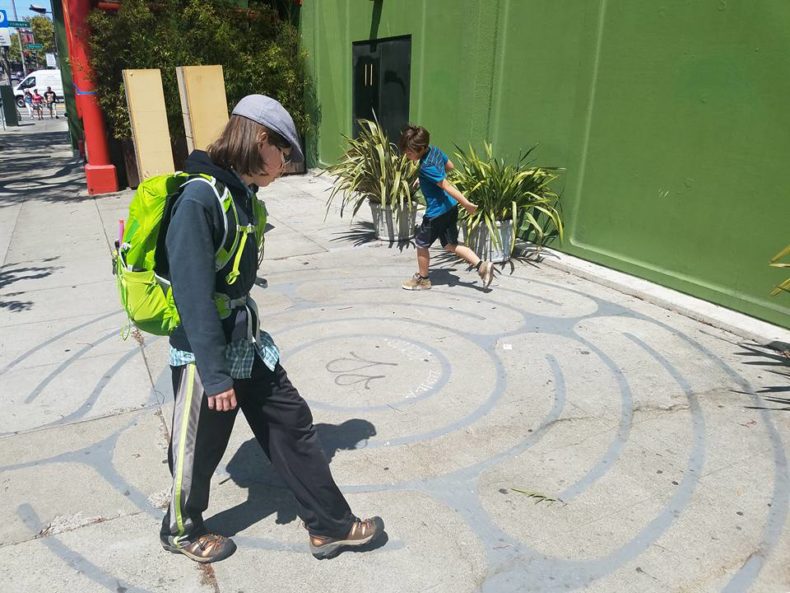
This originally ran August 4, 2017.
There is a difference between the two. In one you can’t get lost; one way in, one way out. The other is full of dead ends and false passages.
I take my kids to labyrinths. When they were little, we walked in socks along the path of a smooth stone labyrinth on the floor of Grace Cathedral in San Francisco. Inside the soaring bay of the cathedral, walking is like gliding, like leaving your body. We wound in and out of each other, the path sometimes bringing us close together, other times sending us apart as we headed from the outside to the center, and from the center back out.
This is a 35-foot-wide replica of the Chartres Cathedral labyrinth, built into to the floor of the French throned church in 1201. According to Labyrinth Guilds caring for these convoluted works of interactive art around the world, these are spiritual artifacts, “divine imprints.” Traveling along one involves three canonical stages: purgation, illumination, and union. Purgation is the entry, leaving the prosaic details of life behind. Illumination is reaching the center. Union is leaving along the same path, joining with God.
This is how my kids learned to do it, and nobody ever told them. They figured out if you spend half an hour walking to the center, you must spend another half an hour walking out.
Mazes, on the other hand, are made of alleys. They have dumpsters and knocked over trash cans. You can get cornered, and at times can’t find the way. I like these, too.
Last week I was in San Francisco with my teenager and his younger brother. We didn’t make it to Grace Cathedral, but instead wandered the rest of the city on foot and with a fistful of public transit passes. The city was a maze of busy streets and buildings rolling up and over hills and down to the water. The first labyrinth we found was by happenstance (pictured above). This was our first night out, a little before midnight. We saw a boulder placed at the open-air entrance to a medical center. We walked to the boulder and found behind it an elaborate, Grace-style labyrinth on the floor. Their daypacks hit the ground as they both started immediately onto the single, looping path. I almost thought of shooing them away from it. It was getting late. But how could I?
When my youngest reached the middle, he dropped to his knees.
The icon of the labyrinth has appeared worldwide, pecked into the rock walls of canyons of the Southwest, in Goa, India, on a coin from Crete in the first few centuries BC, set into the floors of Medieval European cathedrals. The Labyrinth Society has a “Labyrinth Locator” to find one near you.
Mazes are everywhere, too: forests, canyons, mountains, cities. I also take my kids to these. We’ve confounded ourselves on the North Rim of the Grand Canyon and packed through twisting halls of sandstone, some letting us through, some dropping into impassable dryfalls.
Mazes are defined as “confusing intricate networks of passages” or “something confusingly elaborate.” There is no canon for a maze. Have you tried getting off and back on the I-78 Express in Newark? Or written a book, been married, had children? Or done anything at all in your life? You’ve been in a maze.
A labyrinth is more intentional, even if found by accident.
On our last day in San Francisco we happened upon a labyrinth on Geary Street in Japantown (pictured below). It had been painted expertly onto a broad part of the sidewalk. Without hesitation my two boys entered into it, winding toward its center to pause for a moment, then run the same loops back out. I don’t know if I ever taught this to them, or I just showed them a labyrinth and they knew what to do.
Any wild and twisting path, any imprint of the divine, see it through.

Photos: Craig Childs
I love that last sentence! You have true explorers on your hands – no worries, they come by it naturally. An innate common sense and sensitivity will lead and inspire them.
We are fascinated by these. Even though we can see to the center, we have to walk them.
Labyrinths always had a special meaning for me. I had my first kiss in the center of my church’s labyrinth. Reminds me of a quote I heard recently “The path of the heart is not always linear.” Thank you for sharing this beautiful piece.